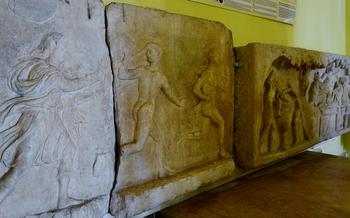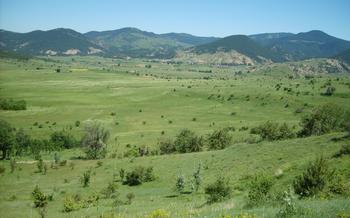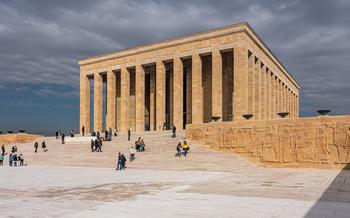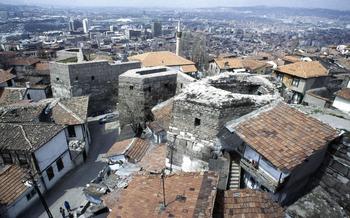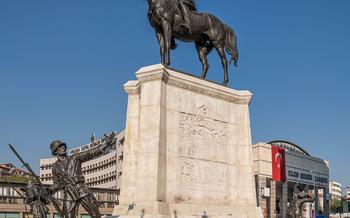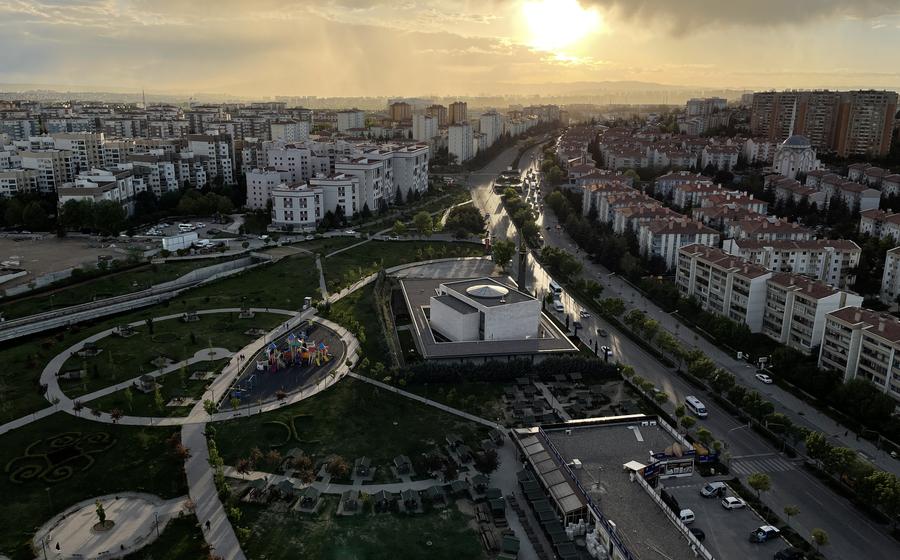
Pembe Köşk Pink Pavilion
- The Pink Pavilion in Ankara
- A Hidden Gem in Ankara's Çankaya District
- History of the Pink Pavilion
- Unique Architectural Features
- Exploring the Interior of the Pink Pavilion
- Current Use of the Pink Pavilion
- The Pink Pavilion's Role in Turkish History
- Interesting Anecdotes and Stories
- Visiting the Pink Pavilion
- Nearby Attractions
- Planning Your Visit
- Capture the Beauty of the Pink Pavilion
- Unforgettable Experiences at the Pink Pavilion
- The Pink Pavilion in Popular Culture
- Insider Tip: Discover Hidden Details
The Pink Pavilion in Ankara
The Pink Pavilion (Pembe Köşk), nestled in the heart of Ankara's Çankaya district, is a captivating architectural gem that holds a significant place in Turkish history. Built in the early 20th century as a residence for Mustafa Kemal Atatürk's mother, Zübeyde Hanım, it showcases a blend of European and Turkish architectural influences. Today, the pavilion serves as a symbol of Turkish history and culture, hosting government offices and occasional public events.
Historical Significance:
The Pink Pavilion stands as a testament to the life and legacy of Zübeyde Hanım, a remarkable woman who played a pivotal role in shaping the history of modern Turkey as the mother of Mustafa Kemal Atatürk, the founder of the Turkish Republic. Built in 1924, the pavilion served as Zübeyde Hanım's primary residence until her passing in 192It also hosted gatherings of prominent figures, becoming a hub for political and social activities.
Architectural Features:
The Pink Pavilion is renowned for its distinctive architectural style, blending European influences with traditional Turkish elements. The vibrant pink exterior, a striking contrast to the surrounding greenery, gives the pavilion its name and iconic status. Its intricate interior features ornate plasterwork, marble fireplaces, and crystal chandeliers, reflecting the opulence and elegance of the era.
Current Use:
Currently, the Pink Pavilion houses government offices and serves as a venue for various cultural exhibitions and events. While it is not open to the public for regular tours, visitors can admire its beauty from afar or catch a glimpse during special occasions when the pavilion opens its doors to the public.
Interesting Anecdotes:
The Pink Pavilion is steeped in intriguing anecdotes and stories that have been passed down through generations. One tale recounts how Zübeyde Hanım, known for her generosity and hospitality, would often host elaborate gatherings at the pavilion, delighting her guests with lavish feasts and lively conversations. Another story tells of a secret tunnel connecting the pavilion to the nearby presidential palace, allowing for discreet movement and communication.
A Hidden Gem in Ankara's Çankaya District
Located in the heart of Ankara's prestigious Çankaya district, the Pink Pavilion stands as a hidden gem waiting to be discovered. Its secluded position, nestled amidst lush gardens and towering trees, creates a peaceful ambiance that contrasts with the bustling city life just beyond its gates.
To reach this architectural treasure, visitors can take a leisurely stroll or a short drive from the city center. The Pink Pavilion's proximity to other notable landmarks, such as the Çankaya Presidential Palace and Anıtkabir (Mausoleum of Atatürk), makes it an ideal stop on a comprehensive tour of Ankara's historical and cultural attractions.
Stepping inside the Pink Pavilion's serene compound, visitors are greeted by a sense of tranquility and a glimpse into a bygone era. Once a private residence, the pavilion exudes a palpable historical charm that transports visitors back in time.
History of the Pink Pavilion
The Pink Pavilion was initially conceived as a hunting lodge for Sultan Abdülaziz, who ruled the Ottoman Empire from 1861 to 187He commissioned the construction of the pavilion in 1871 as a place where he could retreat from the hustle and bustle of palace life and indulge in his passion for hunting.
The construction of the pavilion was entrusted to renowned architect Sarkis Balyan, who was known for his innovative designs and blending of traditional Turkish elements with European architectural styles. Balyan designed the pavilion in a Neoclassical style, incorporating elegant lines, symmetrical proportions, and intricate ornamental details. The distinctive pink color of the exterior, which gave the pavilion its name, is said to have been chosen by Sultan Abdülaziz himself, who was reportedly captivated by the vibrant hue.
Once completed in 1873, the Pink Pavilion quickly became a favorite retreat for Sultan Abdülaziz. He often spent his weekends and holidays at the pavilion, indulging in hunting expeditions and enjoying the tranquility of the surrounding nature. The pavilion also served as a venue for lavish parties and receptions, where the sultan entertained his guests and celebrated special occasions.
Unique Architectural Features
The Pink Pavilion stands out with its distinctive architectural features, blending European influences with traditional Turkish elements. Its exterior is adorned with a vibrant pink hue, giving it its iconic name. The intricate details of its facade, such as arched windows, decorative moldings, and ornate balconies, showcase the architectural style popular in the late 19th century.
The interior of the Pink Pavilion is equally impressive, boasting grand entrance halls, exquisite reception rooms, and private living quarters. Each room is adorned with intricate details, such as ornate chandeliers, marble fireplaces, and parquet flooring. The walls are adorned with elegant paintings and tapestries, creating a sense of grandeur and sophistication.
The pavilion's design reflects the influence of European architecture, with its symmetrical layout and classical proportions. However, it also incorporates elements of traditional Turkish architecture, such as the use of domes and the incorporation of intricate tilework and calligraphy. This fusion of architectural styles creates a unique and harmonious blend that is characteristic of many buildings from the late Ottoman period.
Overall, the Pink Pavilion's architectural features showcase the blending of European and Turkish influences, creating a visually striking and historically significant structure that is a testament to the architectural prowess of its time.
Exploring the Interior of the Pink Pavilion
The interior of the Pink Pavilion is as captivating as its exterior, showcasing a blend of grandeur, elegance, and intricate details. Upon entering the grand entrance hall, visitors are greeted by a soaring ceiling adorned with ornate chandeliers and delicate frescoes. The walls are adorned with mirrors that reflect the light, creating an illusion of spaciousness.
Exquisite reception rooms flank the entrance hall, each boasting unique features. One room features a fireplace surrounded by intricately carved marble mantel, while another displays a collection of antique furniture and artwork. The private living quarters, once occupied by the pavilion's notable residents, offer a glimpse into their lives, with beautifully appointed bedrooms, dressing rooms, and private studies.
Throughout the pavilion, original features have been meticulously preserved, allowing visitors to experience the ambiance of a bygone era. The intricate plasterwork, hand-painted ceilings, and parquet floors have been restored to their former glory, creating a sense of timelessness.
Current Use of the Pink Pavilion
The Pink Pavilion serves various purposes in contemporary Ankara. It primarily functions as government offices, housing administrative departments and officials. However, it also plays a vital role in preserving Turkish history and culture. The Pink Pavilion periodically opens its doors to the public for special events and cultural exhibitions. These events showcase Turkey's rich heritage and provide a platform for local artists and performers to showcase their talents. The pavilion's stunning architecture and historical significance make it a popular venue for conferences, seminars, and diplomatic gatherings. By hosting these events, the Pink Pavilion continues to be a living symbol of Turkey's cultural diplomacy and international engagement.
The Pink Pavilion's Role in Turkish History
The Pink Pavilion has played a significant role in Turkish history, serving as a witness to important events and a symbol of political power. It was the residence of prominent figures, including Mustafa Kemal Atatürk, the founder of the Turkish Republic. The pavilion has become an integral part of Turkey's cultural heritage and represents a tangible link to the country's past.
The Pink Pavilion has witnessed firsthand many of the defining moments of modern Turkish history. It was here that Atatürk received foreign dignitaries and held meetings that shaped the course of the nation. The pavilion was also a venue for important ceremonies and events, including the signing of the Treaty of Lausanne in 1923, which recognized the independence of the Turkish Republic.
The Pink Pavilion has been home to some of Turkey's most influential leaders, including İsmet İnönü, the second president of the Republic, and Celal Bayar, the third president. These statesmen used the pavilion as their official residence and conducted much of their governmental business within its walls.
Through the years, the Pink Pavilion has evolved into a symbol of Turkish history and culture. It represents the country's rich heritage and its journey towards becoming a modern and independent nation. Visitors to the pavilion can feel a sense of history as they walk through its grand halls and admire its exquisite architecture, gaining a glimpse into the past that has shaped modern-day Turkey.
Interesting Anecdotes and Stories
The Pink Pavilion is a treasure trove of fascinating stories and anecdotes that have been passed down through generations. One intriguing legend claims that the pavilion was built on the site of an ancient Roman temple dedicated to the goddess Venus. According to the tale, the temple was destroyed by an earthquake, and the pavilion was erected in its place as a symbol of hope and renewal.
Another anecdote tells the tale of a former occupant of the pavilion, a wealthy Ottoman merchant named Süleyman Efendi. Süleyman Efendi was known for his lavish parties and extravagant lifestyle. It is said that he once hosted a party so grand that the guests danced and feasted for three days and three nights.
The pavilion also played a role in Turkish politics. During the early days of the Turkish Republic, the pavilion was used as a meeting place for political leaders and foreign dignitaries. It is rumored that some of the most important decisions in Turkish history were made within the walls of the Pink Pavilion.
These are just a few of the many stories that surround the Pink Pavilion. Each anecdote adds to the mystique and charm of this historic building, making it a must-visit destination for anyone interested in Turkish history and culture.
Visiting the Pink Pavilion
To fully appreciate the grandeur and historical significance of the Pink Pavilion, visitors are encouraged to take part in a guided tour. Knowledgeable guides provide insights into the history, architecture, and significance of the building, bringing its stories to life. Guided tours are offered on a regular basis and can be booked in advance or arranged upon arrival.
For those who prefer to explore at their own pace, the Pink Pavilion is also accessible to the public during certain hours. Visitors can wander through the grand entrance hall, admire the intricate details of the reception rooms, and peek into the private living quarters. The preservation of original features throughout the building ensures an immersive experience that transports visitors back in time.
It is important to note that the Pink Pavilion is a government building and certain areas may be restricted for security reasons. Visitors are advised to dress respectfully and follow the etiquette guidelines provided by the staff. Photography is permitted in most areas, but it is essential to respect the privacy of any individuals who may be present during the visit.
Nearby Attractions
The Pink Pavilion is situated in the heart of Ankara's historic Çankaya district, making it an ideal starting point for exploring the city's other renowned attractions. A short walk away is the Çankaya Presidential Palace, the official residence of the Turkish President. Visitors can admire the grandeur of this modern architectural marvel, set amidst lush gardens.
Another must-visit site is Anıtkabir, the mausoleum of Mustafa Kemal Atatürk, the founder of modern Turkey. This awe-inspiring complex showcases Atatürk's life and achievements through exhibits, artifacts, and a symbolic flame that burns eternally.
For a glimpse into Turkey's rich history and cultural heritage, head to the Museum of Anatolian Civilizations. This world-renowned museum houses an impressive collection of artifacts from ancient civilizations that once thrived in Anatolia, including the iconic Hittite sculptures.
To experience the grandeur of modern Turkish architecture, visit the Kocatepe Mosque, the largest mosque in Ankara. Its striking white minarets and opulent interior decorations are a testament to the city's vibrant Islamic heritage.
Planning Your Visit
To make the most of your visit to the Pink Pavilion, careful planning is essential. The best time to visit is during the spring or fall when the weather is pleasant, and the crowds are smaller. Guided tours are available and offer an in-depth look into the history and significance of the pavilion. It's advisable to book your tour in advance, especially during peak tourist season.
The duration of the tour typically ranges from one to two hours. If you have limited time, you can opt for a shorter tour that focuses on the highlights of the pavilion. However, if you're interested in a more comprehensive experience, consider taking a longer tour that delves into the intricate details of the architecture and history.
To enhance your visit, combine it with other attractions nearby. The Çankaya Presidential Palace, Anıtkabir (Mausoleum of Atatürk), Museum of Anatolian Civilizations, and Kocatepe Mosque are all within easy reach of the Pink Pavilion. This allows you to create a comprehensive itinerary that showcases the rich history and cultural heritage of Ankara.
Capture the Beauty of the Pink Pavilion
The Pembe Köşk offers plenty of opportunities to capture its beauty and grandeur through photography. To make the most of your visit, consider these tips:
Use Natural Light: The pavilion's interiors and exteriors are bathed in natural light, which creates stunning effects depending on the time of day. Choose a clear, sunny day for your visit to take advantage of the natural lighting.
Capture Unique Angles: Don't just stick to traditional frontal shots. Experiment with different angles and perspectives to capture the pavilion's intricate details and surrounding gardens.
Respect Privacy: While photography is allowed in most areas, be mindful of the pavilion's current use as a government building. Respect the privacy of staff and visitors, and avoid taking photos that may compromise their security or confidentiality.
Learn from the Experts: The pavilion's knowledgeable staff is always happy to assist visitors with photography. Ask them about the best spots to take photos and any special considerations you should keep in mind.
Explore Hidden Corners: Take some time to explore the pavilion's hidden corners and less-visited areas. You might discover unique architectural elements or serene spots that make for captivating photographs.
Unforgettable Experiences at the Pink Pavilion
The Pembe Köşk offers a remarkable backdrop for a wide range of unforgettable experiences designed to transport visitors back in time. History buffs can immerse themselves in historical reenactments, where actors dressed in period costumes bring to life the stories of the pavilion's past residents. The grand halls and elegant rooms provide a stunning setting for concerts, performances, and cultural events, showcasing Turkey's rich artistic heritage.
For those seeking a truly unique and memorable occasion, the Pembe Köşk can be reserved for private events such as weddings, anniversaries, and corporate functions. Imagine exchanging vows in the exquisite reception room or hosting a gala dinner surrounded by the pavilion's opulent furnishings. The dedicated staff is on hand to ensure that every detail is meticulously planned and executed, creating an unforgettable experience that will leave a lasting impression on guests.
The Pink Pavilion in Popular Culture
The Pink Pavilion's distinctive appearance and intriguing history have made it a popular subject in popular culture. It has been featured in several movies and TV shows, including the Turkish historical drama "Kurtuluş" (1994) and the international spy thriller "Taken 2" (2012). The pavilion's opulent interiors and serene gardens have also served as a backdrop for fashion shoots, music videos, and commercials.
In literature, the Pink Pavilion has been mentioned in novels, short stories, and travelogues. Turkish author Ahmet Hamdi Tanpınar featured the pavilion in his classic novel "Saatleri Ayarlama Enstitüsü" (1954), describing it as a symbol of the country's changing political and social landscape. International writers have also been drawn to the pavilion's allure, with British novelist Elif Shafak using it as a setting in her book "The Forty Rules of Love" (2009).
Beyond the world of fiction, the Pink Pavilion has also been used in advertising and marketing campaigns. Its unique aesthetic has made it a popular choice for brands looking to convey a sense of luxury and heritage. The pavilion has also been a source of inspiration for artists and designers, who have incorporated its architectural elements and color palette into their work.
Whether through film, literature, or advertising, the Pink Pavilion has captured the imagination of people around the world, solidifying its status as a cultural icon.
Insider Tip: Discover Hidden Details
The Pembe Köşk is a treasure trove of hidden details waiting to be discovered by curious visitors. As you explore the mansion, keep an eye out for intricate carvings, decorative tiles, and unique architectural elements that may have gone unnoticed at first glance. The surrounding gardens also hold hidden gems, such as secluded corners, sculptures, and fountains. Don't hesitate to ask the knowledgeable staff about the history and significance of these hidden details, as they can provide fascinating insights into the life and times of the Pembe Köşk's former occupants. Additionally, inquire about special events or activities that may be happening during your visit, as these can offer a unique opportunity to experience the mansion in a different light.



